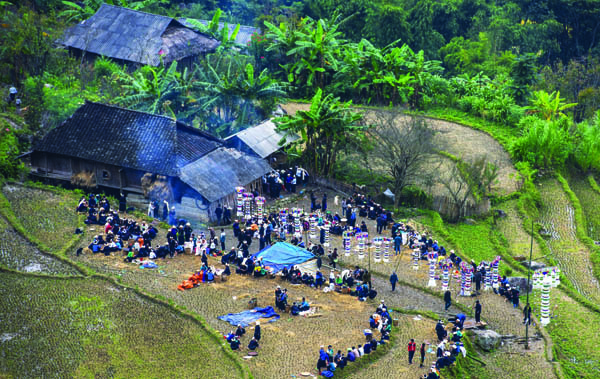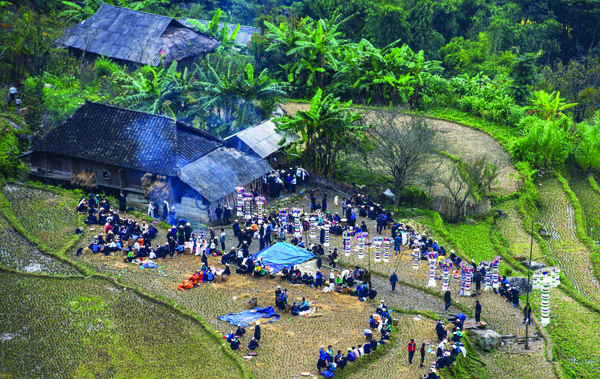(No.3, Vol.8,Jun-Jul Vietnam Heritage Magazine)
Rolls of votive money hanging outside and villagers attending at a dry soul consecration ceremony.

Offering to the dead

A dry soul consecration ceremony of the Nung people, Hoang Su Phi District, Ha Giang Province, 2015. The white band winding on the family members’ heads signifies a connecting bridge that brings the dead home.
Photos: Chu Viet Bac

THE ELABORATE ENRICHMENT CEREMONY OF THE NUNG
The Nung people, one of the ethnic minorities in Hoang Su Phi District of Ha Giang Province, have a very unique dry soul consecration ceremony that reflects the deep emotional attachment and love they dedicate to their deceased.
The dry soul consecration ceremony is intended to see the soul of the deceased off to the land of ancestors. Sometimes after the funeral, after the dead body is already buried, the family chooses a good day to conduct the ceremony.
The dry soul consecration ceremony usually takes place at year’s end when the amount of field work is reduced.
The ceremony has many rituals. First, the family conducts the soul calling ritual for the deceased. Clan members, villagers and friends from other places come to attend this ritual.
Nung people believe that after death the deceased souls are all taken by the two brothers, kings of heaven, to be their slaves. To call a soul, they make a flag that bears the picture of a person and some animals and hang it high so that the soul can see from far away to recognize the way home.
Descendants and family members of the deceased make offerings to the two kings of heaven. The offerings are arranged in a two-storey teepee, the upper tray for the elder brother and the lower tray for the younger one. Both the trays contain meat, wine and other offerings. A long white roll of cloth is spread on the stair steps of the teepee and along the path to a little hut with a gate to receive the deceased soul.
Then a shaman calls the deceased’s name, holding a bell and a sword to scare away evil spirits and to lead a procession of mourning relatives and friends who come to receive the soul of the deceased. Each person holds in hand a piece of votive paper and a rice ear, which serve the purpose of showing the dead soul the way home.
After the ritual, the shaman checks two chicken leg bones. If there are four round holes of equal size, the soul is already home. If not, he repeats the ritual again together with the mourning family.
The soul of the deceased will then be carried by the family on a small bamboo palanquin. The white band the family members wind on their head signifies a connected bridge that brings the dead home. A band of drums and gongs closes the end of the procession, playing to chase away lost souls to make way for the deceased’s soul to come home. At home, the shaman conducts a ritual to pray for the deceased soul to be in peace with the ancestors and for the family to live on in love and prosperity.
Now that the soul is home, in the early morning the family has a ritual to hand over some assets to the deceased. Nung people believe that after being released by the heaven kings, the soul is free but has no house and no property to begin a new life. The situation is very difficult. So the family and relatives give some domestic animals to the deceased to begin a new life. First of all, they give a cow buffalo, the most important asset of a farmer. On behalf of the family, the shaman tells the deceased the identifying features of the buffalo by which to recognize and find it if it goes astray in the future. The shaman also encourages the deceased to work diligently to have a prosperous life.
As the shaman conducts this ritual, the family continues mourning. By giving an initial asset to the deceased, they are fulfilling the duties of the living.
After the ritual, the buffalo is slaughtered to treat the attending clan, friends and villagers. But during all the three days of the ceremony, the descendants of the deceased must maintain a pure vegetarian diet. As the sun rises, the relatives and friends bring votive money, pigs and chickens to offer to the deceased. Rolls of colorful and shining votive money represent the money of the other world.
Offerings such as pigs, chickens, rice and wine are brought inside to be offered to the dead soul. The rolls of votive money are hung outside. Hung neatly, these can be seen from far away, and one can guess the age of the deceased. The amount of votive money offered is usually proportionate to the age and number of descendants of the deceased.
Inside, the shaman continues handing over the assets to the deceased. He announces clearly the visitor’s name and the amount of pigs and chickens this person offers. Each one gives a little and all accumulates into a significant amount of wealth. People believe that the deceased would be happy in the other world having enough to build a new good life.
The dry soul consecration ceremony can’t be complete without the horse dance to see the dead soul off to the other world. This dance is performed by two men and includes many acts. First, the men kowtow toward four directions of the universe and towards the pole that held the deceased’s buffalo. Then they show two horses racing. The dance is not only eye-catching and vigorous. It also shows many notions related to agricultural beliefs. Death is considered only the end of one’s existence in this world, and it is also the beginning of another existence in another world, as happy and prosperous as in this world. And so, in that world, the deceased also needs a horse to travel.
In the final ritual of the dry soul consecration ceremony, the little hut and all votive paper items are brought to the grave and burnt.
When everything becomes ashes in the flame, everybody’s heart is at peace, believing the deceased is already in possession of all things needed for a new life.

